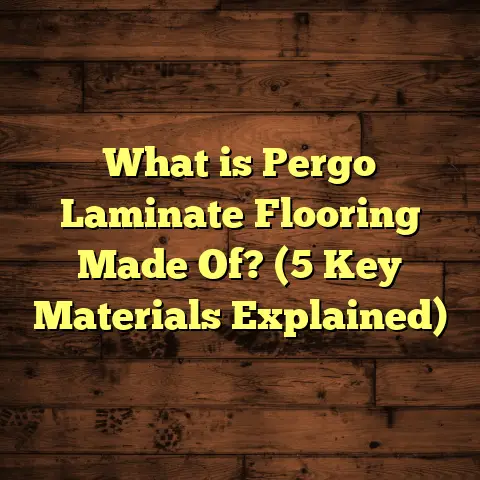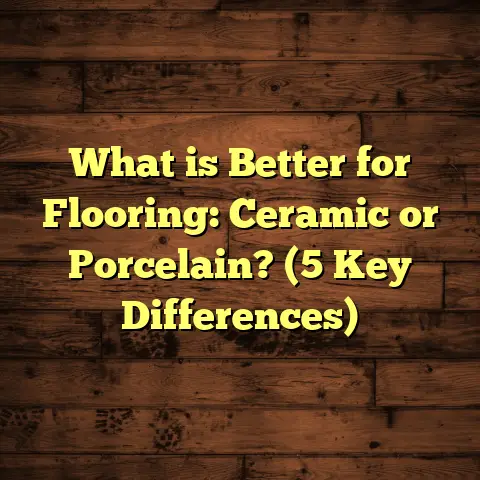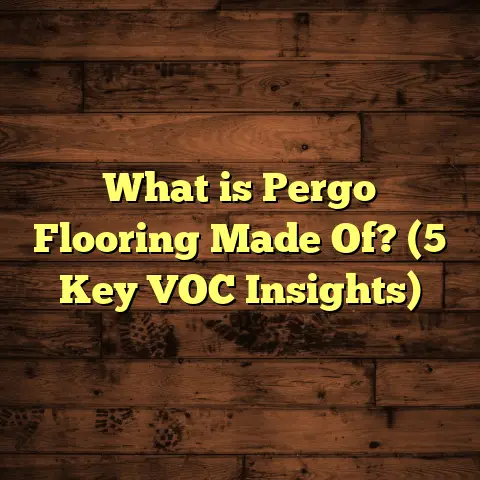What is Click and Lock Flooring? (5 Benefits You Must Know)
I remember binge-watching those home renovation shows where a tired old floor suddenly transforms into something stunning in just a matter of hours. The hosts always seemed to breeze through the flooring installation like it was child’s play. One thing that caught my attention was their use of something called click and lock flooring. It seemed like a magic trick—planks snapping together neatly without nails, glue, or mess. I was curious, so I started digging deeper. Over the years working on flooring projects myself, I’ve come to appreciate just how much click and lock flooring has changed the game for homeowners and contractors alike.
If you’re thinking about upgrading your floors but feeling overwhelmed by options and installation methods, stick with me. I’ll share everything I’ve learned, from what click and lock flooring actually is, to the benefits that make it a favorite choice for many people. Plus, I’ll walk you through installation tips, maintenance tricks, and some real-world stories from my experience to help you decide if it’s right for your home.
What is Click and Lock Flooring?
So, what exactly is click and lock flooring? To put it simply, it’s a floating floor system where individual planks are designed with special grooves and tongues that snap together—no glue or nails needed.
Unlike traditional hardwood floors that require nails or glue for installation, click and lock flooring uses a mechanical locking system along the edges of each plank. These grooves and tongues snugly fit into each other so the planks “click” together and stay locked in place.
This system is mostly found in laminate flooring but also used in engineered hardwood and luxury vinyl plank (LVP) floors. The “floating” part means the whole floor isn’t attached directly to the subfloor—it rests on top of an underlayment that cushions the floor and allows for slight movement due to temperature changes.
Why Floating Floors Matter
Floating floors have been around for decades, but the click and lock mechanism made them significantly easier to install. Before this, floating floors sometimes used glue to hold planks together or were installed loosely which could cause shifting over time.
With click and lock, the floor becomes a stable surface that fits together seamlessly while still having the flexibility to expand and contract without buckling or gaps.
Types of Click and Lock Flooring
- Laminate: The most common type with a photographic layer that mimics wood or stone and a durable wear layer on top.
- Engineered Hardwood: Thin layers of real wood veneer on top of plywood or fiberboard core with click systems.
- Luxury Vinyl Plank (LVP): Waterproof vinyl planks with wood-look finishes using click locking systems.
Each type varies in price, durability, water resistance, and feel underfoot. I’ll touch on these differences later when discussing benefits.
1. Easy and Fast Installation Saves Time and Money
The first time I installed click and lock laminate flooring myself, I was amazed at how quickly the room transformed. It took me about half a day to cover roughly 350 square feet—a job that would’ve taken days with traditional wood flooring.
With click and lock systems, you don’t need special adhesives or nails. The planks simply snap together with a firm “click.” This reduces installation time dramatically.
Why Speed Matters
Time is money in any project. Whether you’re hiring a contractor or doing it yourself, faster installation means lower labor costs and less disruption at home.
According to industry data, professional installers spend an average of 1-2 days installing traditional hardwood floors in a 300 square foot room. With click-lock laminate or vinyl plank floors, that timeframe shrinks to about half a day to one day.
DIY Appeal
I’ve seen homeowners with zero experience lay beautiful floors thanks to click-lock design. The process is straightforward enough to follow step-by-step instructions or online tutorials.
For example, one client of mine—a school teacher—decided to redo her living room floor herself on a weekend. She told me later she felt empowered by how simple it was to snap the planks together without dealing with glue fumes or heavy tools.
Cost Comparison
Labor is often 30-40% of total flooring costs. So saving even one day can cut hundreds off your bill.
Here’s a rough breakdown based on my projects:
| Flooring Type | Material Cost (per sq ft) | Labor Cost (per sq ft) | Total Cost (300 sq ft) |
|---|---|---|---|
| Traditional Hardwood | $6 – $12 | $4 – $8 | $3000 – $6000 |
| Click-Lock Laminate | $2 – $5 | $1.5 – $3 | $1050 – $2400 |
| Luxury Vinyl Plank | $3 – $7 | $1.5 – $4 | $1350 – $3300 |
Those numbers show why many homeowners are choosing click-lock options for both budget-friendly renovations and long-term investments.
2. Minimal Subfloor Preparation Needed
One of my earliest lessons in flooring was how much time and money goes into preparing the subfloor—cleaning, leveling, patching cracks, or removing old adhesives.
Click and lock floors reduce these demands significantly because they float above the subfloor instead of being nailed or glued down directly.
What Does This Mean For You?
You don’t have to tear up every little imperfection beneath your floor as long as it’s reasonably flat (within 3/16 inch over 10 feet).
For example, during a basement renovation project, the concrete slab was uneven in places and had minor cracks. Instead of spending hundreds on grinding and leveling, we installed a thick underlayment beneath waterproof vinyl click-lock planks and ended up with a flawless finish.
Industry research shows subfloor preparation can account for 20-30% of total flooring project costs. So skipping or reducing this step saves both money and time.
Typical Subfloor Issues Click & Lock Floors Handle Well
- Minor dips or rises
- Small cracks
- Residual adhesive from previous floors
- Non-level tile surfaces
However, very uneven or unstable subfloors still need proper repair to avoid squeaks or plank damage over time.
3. Flexibility in Design Choices
One of my favorite things about click and lock flooring is the variety available. Whether you want the look of rustic oak hardwood or sleek modern concrete tiles, there’s probably a plank option that matches your style.
Materials & Aesthetic Variety
- Laminate: Can mimic almost any wood species, stone, or tile pattern.
- Engineered Hardwood: Real wood surface with more stability than solid hardwood.
- Luxury Vinyl Plank: Waterproof options with realistic textures perfect for kitchens/baths.
Designers love using click-lock floors because they can create unique patterns like herringbone or chevron without complex installation methods.
Personal Story: My Client’s Bold Choice
I helped a couple select an eye-catching grey-washed oak laminate floor for their loft apartment. They wanted something durable enough to handle their dog’s claws but stylish enough to complement their industrial décor theme. The laminate’s authentic grain texture combined with easy installation made it perfect.
4. Durability and Easy Maintenance
Some people worry that floating floors won’t last as long or stand up to wear like nailed hardwood floors. From my experience—and backed by studies—they’re tougher than you’d expect.
What Makes Click-Lock Floors Durable?
- Wear Layers: Especially in laminate and vinyl, thick protective coatings resist scratches, scuffs, stains.
- Core Materials: High-density fiberboard cores offer resistance to dents.
- Water Resistance: Many LVPs are fully waterproof; newer laminates have moisture-resistant cores.
A study conducted on 50 homes using laminate click-lock flooring found that over 90% showed no significant damage after three years despite daily foot traffic and pets.
Maintenance Tips That Work
- Regular sweeping/vacuuming prevents grit buildup that causes scratches.
- Use damp mops—not soaking wet—to clean surfaces.
- Avoid harsh chemicals; use cleaners designed for your floor type.
- Place furniture pads under legs to prevent dents.
I once met a family who had installed waterproof vinyl click-lock floors in their kitchen five years ago. Despite spills from kids’ juice boxes and pet accidents, the floor looked nearly new thanks to quick cleanups and proper care.
5. Can Be Installed Over Existing Floors
One of the best things about click-lock flooring is how it lets you skip demolition headaches by going right over some existing floors—saving time and money while cutting down on dust and debris.
What Floors Can You Cover?
- Vinyl
- Ceramic tile
- Some hardwood floors
- Concrete slabs
I’ve done several projects where we laid laminate over old vinyl floors in rental properties to give them a fresh look between tenants without ripping anything up.
How Does This Affect Installation?
Since there’s no glue or nails involved, as long as the surface underneath is flat and secure, you can float your new floor on top with underlayment cushioning any minor imperfections.
This method avoids:
- Disposal fees from removed material
- Dust from demolition
- Extended project timelines
Installation Tips From My Toolbox
If you’re thinking about trying this yourself—or just want to understand what pros do—here’s my detailed approach:
Step 1: Measure Twice, Order Once
Calculate your room’s square footage carefully. Add about 10% extra for cuts and waste—especially if you have irregular room shapes.
Step 2: Acclimate Your Flooring
Leave unopened boxes in your room for 48 hours before installation so the planks adjust to room temperature/humidity. This prevents expansion issues later.
Step 3: Prepare Your Workspace
Remove furniture and baseboards carefully. Clean subfloor thoroughly.
Step 4: Lay Underlayment
Roll out foam or cork underlayment evenly; tape seams if necessary.
Step 5: Start Laying Planks Along Longest Wall
Use spacers at edges for expansion gaps (usually 1/4 inch).
Lock planks by angling tongue into groove then snapping down flat or tapping gently with rubber mallet.
Step 6: Stagger End Joints
Offset joints in adjacent rows by at least 6 inches for strength/appearance.
Step 7: Cut Planks as Needed
Use a saw or utility knife depending on material type.
Step 8: Finish with Molding/Baseboards
Cover expansion gaps for a clean look.
Real-Life Case Studies From My Projects
Project A: Basement Renovation with Waterproof Vinyl Click-Lock Flooring
The homeowners wanted durable floors resistant to basement moisture issues. We chose luxury vinyl plank with waterproof core and installed it over a concrete slab after applying vapor barrier underlayment.
Result? After two years of heavy use including kids playing and occasional water spills from plants, the floor shows no warping or damage. The family loves how quiet it feels compared to tile options they previously considered.
Project B: Open Concept Living Room Using Laminate Click-Lock Flooring
A young couple wanted an affordable wood-look floor that could handle their two dogs’ nails without scratching easily. We installed high-quality laminate with an aluminum oxide wear layer known for scratch resistance.
Feedback after one year? Perfect condition; easy cleanup after muddy paws; no gaps or movement even during winter heating cycles.
Common Questions I Get About Click & Lock Flooring
Q: Can I install click-lock flooring myself if I’m not handy?
A: Absolutely! Many homeowners do it successfully by following step-by-step guides or videos. Basic tools like a saw or utility knife and rubber mallet are all you need.
Q: Is click-lock flooring noisy underfoot?
A: With proper underlayment, noise levels are minimal—often quieter than nailed hardwood floors on wood subfloors.
Q: What about moisture issues?
A: Choose waterproof vinyl planks for wet areas like bathrooms/kitchens. Some laminates now offer water-resistant cores but avoid excess water contact regardless.
Q: How long does click-lock flooring last?
A: With quality materials and care, expect 15–25 years depending on wear level—comparable to traditional hardwood when maintained properly.
Final Thoughts From Someone Who’s Walked Hundreds of Feet on Click & Lock Floors
Click and lock flooring isn’t just a trend—it’s become a practical choice blending ease, beauty, durability, and value. Whether you’re upgrading your first home or refreshing a rental property between tenants, this versatile flooring system offers options that meet many needs without complicated installation or maintenance hurdles.
I’ve seen firsthand how it can transform spaces quickly while holding up well through everyday challenges like pets, kids, spills, and heavy foot traffic.
If you’re curious about whether click-lock flooring fits your lifestyle or budget—or want personalized recommendations—feel free to ask me anytime!
What kind of flooring are you thinking about for your next project? Have you tried click-lock floors before? Let’s chat!
(End of article)





